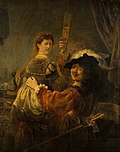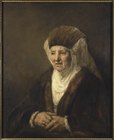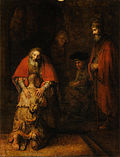Rembrandt
From Wikipedia, the free encyclopedia
Remove ads
Da Rembrandt Harmenszoon van Rijn, bekannt mid seim Voanama Rembrandt (* 15. Juli 1606 z Leiden; † 4. Oktoba 1669 z Amsterdam) is oana vo de berihmtasdn Mola und Grafika vo oin Zeidn. Sei Weak zejd zum Barock und zum Goidnan Hollendischn Zeidoita. Ea is scho zu Lebzeidn gfeiad woarn, is owa wegn ana Pleite vaoarmt gstoarm.




Seine Moastaweake san voa oim Portrets und Illustrationa vo Bibegschichtn. In seine vuin Sejbstportrets zoagt a ned de gringste Eitlkeit und hod damid a authentische Autobiographie gschoffa. In seine Bibegschichtn losst a sei broads Wissn und sei Beobochtung vom Amsterdama Judndum eine fliassn.[1]
Remove ads
Weak
- De Stoanigung vom Heilign Stephan, 1625
- Da Kinstla in seim Studio, 1629
- Parable of the Hidden Treasure, c. 1630
- Jeremiah Lamenting the Destruction of Jerusalem, c. 1630
- Paul the Apostle in Meditation c. 1630
- The Philosopher in Meditation, 1632
- Anatomy Lesson of Dr. Nicolaes Tulp, 1632
- Portrait of Johannes Wtenbogaert, 1633 – a preacher, like many of the best portraits of the 1630s
- Abraham and Isaac, 1634
- Descent from the Cross, 1634
- Saskia as Flora, 1635
- Rembrandt and Saskia pose as "The Prodigal Son in the Tavern" – a portrait historié, 1635
- The Blinding of Samson, 1636, which Rembrandt gave to Huygens
- Belshassar's Feast, 1636-8
- A Polish Nobleman, 1637
- The Archangel leaving Tobias, 1637
- The Risen Christ Appearing to Mary Magdalen, 1638
- The Landscape with Good Samaritan, 1638
- The Mill, 1648
- Bathing woman, modelled by Hendrickje, 1654
- Bathsheba at Her Bath, also modelled by Hendrickje, 1654
- Portrait of the later mayor Jan Six, a wealthy friend of Rembrandt, 1654
- Portret vo am oidn Weib, 1655
- Jacob Blessing the Sons of Joseph, 1656
- Portret vo am ausweatign Admiral, 1658.
- The Syndics of the Drapers' Guild, 1662
- De Konspiration vom Claudius Civilis (cut-down), 1661–62
- The Return of the Prodigal Son, c. 1669
Remove ads
Haptweak im Iwablick
- De Stoanigung vom Heilign Stephan (1625) – Musée des Beaux-Arts, Lyon
- Andromeda Chained to the Rocks (1630) – Mauritshuis, Den Haag
- Jacob de Gheyn III (1632) – Dulwich Picture Gallery, London
- Philosoph in Meditation (1632) – The Louvre, Paris
- The Anatomy Lesson of Dr. Nicolaes Tulp (1632) – Mauritshuis, The Hague
- Artemisia (1634) – Oil on canvas, 142 × 152 cm, Museo del Prado, Madrid
- Descent from the Cross (1634) – Oil on canvas, 158 × 117 cm, looted from the Landgrave of Hesse-Kassel, Germany in 1806, currently Hermitage Museum, St. Petersburg
- As Fest vom Belshazzar (1635) – National Gallery, London
- The Prodigal Son in the Tavern (c. 1635) – Oil on canvas, 161 × 131 cm Gemäldegalerie Alte Meister, Dresden
- Danaë (1636–1643) – Eremitage, St. Petersburg
- De Nochtwoch, formally The Militia Company of Captain Frans Banning Cocq (1642) – Rijksmuseum, Amsterdam
- Christ Healing the Sick (etching c. 1643, also known as the Hundred Guilder Print), nicknamed for the huge sum paid for it
- Boaz and Ruth (1643) aka The Old Rabbi Old Man Woburn Abbey, Gemaldegalerie, Berlin
- The Mill (1645/48) – National Gallery of Art, Washington, D.C.
- Old Man with a Gold Chain ("Old Man with a Black Hat and Gorget") (c. 1631) Art Institute of Chicago
- Susanna and the Elders (1647) – Oil on panel, 76 × 91 cm, Gemäldegalerie, Berlin
- Aristotle Contemplating a Bust of Homer (1653) – Metropolitan Museum of Ar], New York
- Bathsheba at Her Bath (1654) – The Louvre, Paris
- Christ Presented to the People (Ecce Homo) (1655) – Drypoint, Birmingham Museum of Art
- Selfportrait (1658) – Frick Collection, New York
- The Three Crosses (1660) Etching, fourth state
- Ahasuerus and Haman at the Feast of Esther (1660) – Pushkin Museum, Moscow
- The Conspiracy of Claudius Civilis (1661) – Nationalmuseum, Stockholm (Claudius Civilis led a Dutch revolt against the Romans) (most of the cut up painting is lost, only the central part still exists)
- Syndics of the Drapers' Guild (Dutch De Staalmeesters, 1662) – Rijksmuseum, Amsterdam
- De jidische Braut (1665) – Rijksmuseum, Amsterdam
- "The Entombment Sketch" (c. 1639 and reworked c. 1654) oil on oak panel Hunterian Museum and Art Gallery, Glasgow
Remove ads
Beleg
- Clark 1969, S. 203–204
Wikiwand - on
Seamless Wikipedia browsing. On steroids.
Remove ads




























